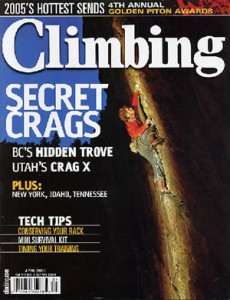 By Michael Silitch
By Michael Silitch
Autobloc belay devices offer many advantages over standard belay devices. Belaying a second directly from the anchor in the auto-blocking mode gives the belayer more comfort at the belay stance, and more security when catching a fall. Once you catch a fall, you don’t even have to worry about escaping the belay if you need to, because you’re already removed from the system.
Release the hounds.
One situation that intimidates some climbers, however, is what to do if the second falls and you need to lower him or her down. Here’s how to release the brake on an autobloc in three simple steps:
- Build a back-up Münter hitch on the brake hand side of the rope and secure it to your belay loop with a locking carabiner.
- Girthhitch a double-length runner to the blocking carabiner. Run the sling up through the carabiner of a higher belay-anchor point such as the “shelf” of the cordalette or one of the higher pieces of gear. Clip the other end of the sling to the belay/rappel loop of your harness. Shorten the sling as needed with an overhand knot so you can pull on the sling with body weight.
- With one hand firmly gripping the brake-hand side of the Münter hitch, pull back and down with your body to release the “lock” of the autobloc. Once “unlocked,” just start lowering the climber using the Münter hitch.
Warning: This release is like learning to drive a car with a manual transmission — the clutch action is all or nothing. That’s why you have the back-up Münter hitch. With practice this technique is smooth, fast, and efficient.
Raising a stuck second.
One of the myriad benefits of belaying a second with an autobloc is that if he can’t do a move, you can set up a quick pulley system and haul him over his trouble spot before he has time to get discouraged. Here’s how:
- Put a prusik on the weighted (climber) side of the rope. Clip the loose (brake hand) side of the rope to the prusik with a carabiner.
- Voila! Just pull on the brake rope that’s clipped to the prusik biner. You now have a 3:1 pulley system with a built-in locking ratchet thanks to the autobloc. This works well if you have a light partner or if you’re strong. If you need more mechanical advantage to make it easier, read on.
- Put a second prusik on the brake rope where you have been pulling your 3:1.
- Take the loose strand of rope coming from your anchor-point knot and clip that to a locking biner on the second prusik.
- Voila, part two! Now pull on the loose end of that second strand. You now have a 6:1 pulley system and can pull just about anything up. Now you’re set to get the most out of your autobloc. Be safe and be sure to practice in your living room first, before moving on to a safe cragging situation where you can practice releasing the autobloc while your test subject is secured with a back-up belay.
Michael Silitch is an American UIAGM internationally certified Mountain and Ski guide and an AMGA Rock, Alpine, Ski guide. He currently lives and works in the Alps. www.high-alpine.com .










